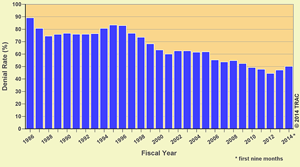The odds of an asylum claim being denied in Immigration Court have been rising. After reaching a historic low of only 44.5 percent turned down in FY 2012, the asylum denial rate rose to 47.2 percent in FY 2013 and has reached 50.2 percent during the first nine months of FY 2014. While this rate is higher than it has been since FY 2009, it is still much lower than ten years ago when almost two out of three (62.6%) individuals seeking asylum lost their cases (see Figure 1).
The number of asylum cases decided by Immigration Judges has fallen from a high-water mark of 35,782 cases in FY 2003. By FY 2010, that number had dropped precipitously to just 19,445. In the following year the count rebounded slightly, reaching 22,040. Since then, however, the number of immigration asylum cases being heard in Immigration Court has declined: during FY 2013 there were 20,941 cases decided, and the pace during FY 2014 has been slightly lower still[1] (see table: Asylum Decisions in Immigration Courts).
These latest Immigration Court numbers are based on case-by-case information obtained by TRAC under the Freedom of Information Act from the Executive Office for Immigration Review (EOIR).
Judge-by-Judge Asylum Decisions: New Reports Released
TRAC's report series on asylum decisions for each Immigration Judge[2] has been updated through the first nine months of FY 2014. As in the past, whether an individual request for asylum is approved or denied is still heavily dependent upon the judge who was assigned to decide the case.
The 2014 reports on each individual Immigration Judge, with year-by-year denial rates and current comparative rankings, can be viewed at TRAC's judge-by-judge menu page.
An overview of judge asylum rates court-by-court, based upon each judge's report, is listed in this appendix: Judge-by-Judge Asylum Decisions in Immigration Courts.
[1]These counts represent all asylum decisions made in a given year, and include asylum decisions made after an appeal and remand.
[2]To be included in this series, a judge must have made at least 100 asylum decisions during the reporting period.
